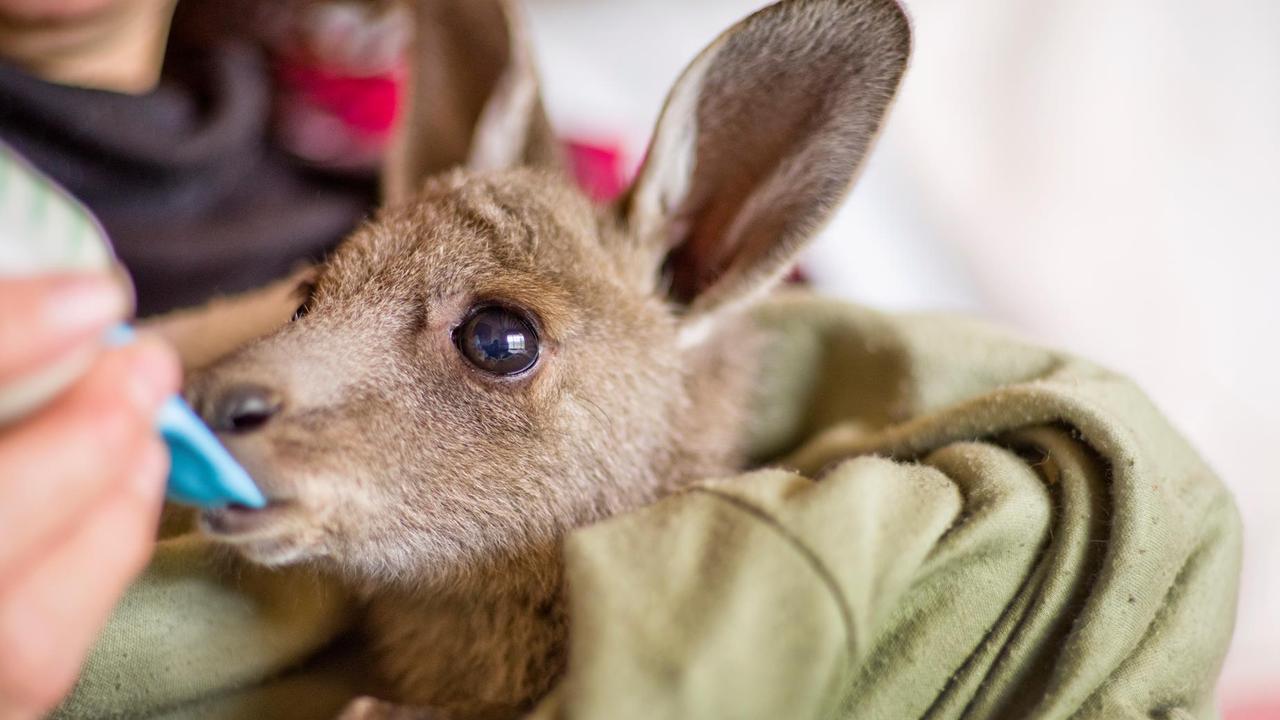Great Ocean Road fires: How a bushfire burnt Christmas Day
IT STARTED with a bolt from the sky. And just as holidaymakers were sitting down to a festive lunch, many had to flee as flames roared through the bush.

VIC News
Don't miss out on the headlines from VIC News. Followed categories will be added to My News.
- Our blackest day since 2009
- Wye River in ruins while Lorne has lucky escape
- Fire victims prepare to visit properties
- Lorne back in business, but heed warnings
- Victoria fire alerts: Key events
IT STARTED with a bolt from the sky. As the mercury soared beyond 40C last Saturday, thunderstorms raged over the Great Otway National Park.
Jolts of lightning battered the area, including a single strike on the Jamieson Track — about 8km west of Lorne — that sparked a bushfire.
Initially, the flames did not spread too far. By Christmas Eve, the fire had razed just 250ha of forest, a small area compared to many bushfires.
But the hilly terrain was proving to be a nightmare for firefighters.
They called in waterbombing aircraft to help as they watched the weather forecasts and worried about the winds picking up.
By Christmas morning, their worst fears were realised.

Embers started spotting beyond containment lines, and within minutes the bushfire had turned into Victoria’s most destructive blaze since Black Saturday.
Fire authorities made the call to evacuate Wye River and Separation Creek at midday.
Just as holidaymakers and permanent residents were taking their turkeys out of the oven, police started knocking on their doors with dire warnings. An evacuation plan had been in the works for several days, but once it was put into action, there was no time to waste, lunch or not.
Tom Jacobs was one of those to quickly jump into his car and head for safety.
“We were about to have lunch and then we saw smoke behind the property,” Mr Jacobs said.
“It kept on coming up bigger and bigger, and then it turned into a war zone with four choppers bombing directly overheard.
“It had all been perfectly fine and then it went dark and it was like volcano skies.”

He made several videos on the road out of Separation Creek, posting them on Twitter on Friday afternoon.
The spectacular beachside town was blanketed in a huge cloud of thick black smoke and surrounded by intense flames.
Mr Jacobs later shared videos of the desperate waterbombing mission to save the towns, and at 10.30pm he found out that his home was still standing.
Dozens of others were not so lucky.

While weekend visitors sped home to Melbourne, those who live in Wye River and Separation Creek took shelter at relief centres in Apollo Bay and Torquay.
Instead of Christmas leftovers, they tucked into pizza and water for dinner. They slept in beds provided by the Salvation Army.
And when they woke up on Boxing Day, they wondered if they would ever see their homes again.
Craig Lapsley says Wye River is a beautiful beachside getaway, and he is not alone in that opinion. But the Emergency Management Commissioner’s visit to it on Christmas Eve was strictly business.
“I was briefed by the captain of the fire brigade about exactly what the fire would do,” Mr Lapsley said. “It was a matter of which day it was going to do it.”

Christmas Day was clearly going to be hot. But while total fire bans were in place, Mr Lapsley said the fire danger did not appear to be extreme, and he was happy with the control work done by firefighters.
“However, they said it will all be about wind,” Mr Lapsley recalled.
“It’ll be about wind that picks up a fire, picks up an ember and puts it over the control lines ... That actually happened on Friday.
“It was a little bit premature in the sense that we expected it not to be on a day that it was 32C with wind speeds of 40, 50, 60km/h. We thought it would have been a day of 40+C with 80, 90, 100km/h winds. But it happened.”

By 9am, the temperature had already topped 27C and northerly winds reached 33km/h.
Spot fires started beyond the containment lines and the bushfire blew wildly out of hand. By Christmas night, the CFA said the blaze was so powerful that it was creating its own weather conditions.
Fire authorities now believe it’s a bushfire that could still be burning in February.
While fires have ravaged the Otway Ranges before — particularly on Ash Wednesday — Wye River had escaped unscathed for decades.
Mr Lapsley said the only significant fires that impacted the township were in 1939 and 1962.
Now 2015 has been added to the history books.
We lost everything

BUILDING records show there are 334 homes in Wye River and Separation Creek.
But only 80 properties are permanent households and one of them belonged to the Maly family.
Tony Maly built his Durumbil Ave home with his father in 1957. The family used the property as a holiday getaway for decades until he and wife Lesley moved in permanently two years ago.
They were set to enjoy Christmas lunch together this year with their pet dog Occy and cat Muppet.
But Mr Maly is a CFA volunteer. And like so many others, he gave up his Christmas Day to fight the fire on the front line.
Little did he know that he would watch the home he built from scratch go up in flames.
“We’ve lost everything,” Mrs Maly said. “I walked out with about five items of clothing, my wedding rings, phone and chargers — everything else is gone.
“I had just put the turkey in the oven when we were told to evacuate. It was surreal ... I was walking down the driveway just thinking, this could be the last time I see my house.”

Her husband made the “gut-wrenching” phone call yesterday morning to tell his wife the fate of their home.
Occy escaped with Mrs Maly but Muppet was lost. Priceless sentimental items, including the couple’s wedding photos, could not be salvaged.
In nearby Karingal Dr, the road that runs along the top of the hill above Wye River, at least another dozen homes were destroyed.
The Sunday Herald Sun visited yesterday as firefighters continued to extinguish spot fires in the smouldering street.
Burnt gum trees and branches were still falling, sending loud cracks echoing through the deserted streets. Broken power lines littered the roads and ash embers flew through the air.

A koala lay dead at the foot of one driveway after the tree it was hiding in caught alight and crashed to the ground.
Such was the sheer intensity of the heat that it was hard to see anything beyond twisted iron roofing and collapsed brickwork in the devastated properties.
Residents had fled in a hurry but it wasn’t hard to imagine what they had left behind.
Children’s toys melted into an unrecognisable mess before they were even unwrapped.

Hams scorched before they were carved. Bonbons burnt before families could crack them and swap jokes.
Three Metropolitan Fire Brigade crews roamed the area yesterday, fulfilling the demoralising duty of assessing which homes had withstood the carnage.
By late yesterday, Mr Lapsley confirmed at least 116 homes destroyed — 98 properties had been destroyed at Wye River and 18 at Separation Creek.
The Insurance Council of Victoria declared the Great Ocean Rd fire to be a catastrophe and said it anticipated claims of more than $25 million.

But as the extent of the damage emerged, authorities confirmed that no lives had been lost and just three firefighters injured.
In the face of such destruction, it was cause for celebration.
“We always say primacy of life is the critical issue in the state,” Mr Lapsley said.
“They’ve walked away from a fire that had every potential to be a killer. That’s success.”
Premier Daniel Andrews expressed similar sentiments when he met with locals at the Apollo Bay relief centre.
“We’ve had no loss of life,” Mr Andrews said. “That’s something that we can be very proud of. We can rebuild houses, of course, but things can be much worse than that.”

FOR much of Christmas Day, it looked like the bushfire was going to burn all the way to Lorne.
A haunting emergency siren rang out on the deserted foreshore as those who had packed the popular town raced to safety.
Those emergency warnings were lifted on Boxing Day when heavy rain gave firefighters the boost they needed, slowing the flames.
The moment the skies opened brought relief — but Mr Lapsley warned it would only be temporary.
“This fire doesn’t go away,” Mr Lapsley said. “This fire is a fire that will remain with potential to burn in January and February.

“The forecast for a long, hot, dry summer is there. The fact that we’ve had rain today across the state will not dramatically change anything. It’ll be a short-term relief for fire conditions.”
Fire authorities met with the concerned organisers of the popular Falls Festival yesterday as they sought to decide if the popular music event should go ahead in Erskine Falls above Lorne. A decision was due last evening.
The mercury is expected to soar beyond 30C again on New Year’s Eve but early forecasts suggest there won’t be strong winds to cause another extreme fire day.
Thousands of other Victorians weighed up their holiday travel plans to the surf coast as Mr Lapsley asked for care and caution.

“Everything is available to burn and that will be the critical period,” he said.
“Don’t underestimate what that means for Victoria on New Year’s Eve and New Year’s Day.
“We have fire in the landscape that will not be extinguished in its totality and on the wrong day with the wrong conditions it will impact on other communities.”
Incident controller Alistair Drayton also preached caution at a community meeting in Torquay, but he encouraged holidaymakers not to abandon the area.
“Lorne is open for business,” Mr Drayton said. “It’s summer, it’s tourism. We’re very conscious of trying to reinstate Lorne as quickly as we could.”

YOU can’t mistake the smells of Christmas Day.
There’s the memorable scent of pine that fills your nostrils as your family tears open presents around the tree.
There’s aroma of the turkey when you take it out of the oven. The mouth-watering pudding that you can’t resist, no matter how many second helpings you had during main course.
But for thousands of Victorians, this year’s Christmas will be remembered by the acrid smell of smoke.
Where there was smoke, there was fire.
And where there was fire, there was a 2200ha path of devastation that will forever scar the picturesque Great Ocean Rd coastline.
— with Andrea Hamblin, Lucie Morris-Marr and Margaret Linley


